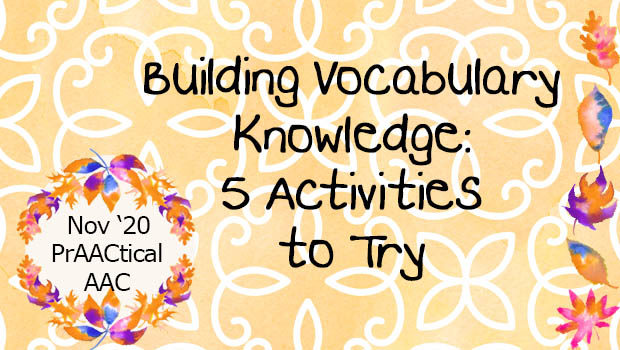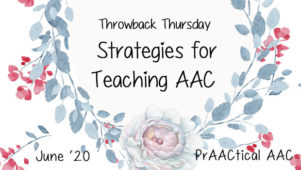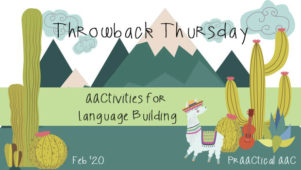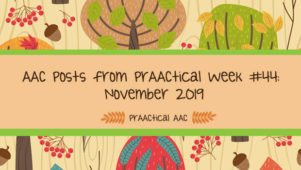Building Vocabulary Knowledge: 5 Activities to Try

You’ve developed a list of target words for vocabulary instruction and are modeling them frequently throughout the day using aided language input. Focused language stimulation helped, and when you created materials that have the target word with a student-friendly definition, a relevant picture, synonyms, and a sample sentence, things looked promising. Your client seemed to notice, was sometimes attentive, and showed indications that their awareness of these words was growing. However, in terms of truly understanding these words or using them, progress was s-l-0-w.
Where can you go from here? Explicit instruction on these words will help speed up the learning curve.
Here are some activities you can embed in your teaching and therapy to provide more experience with this new vocabulary.
- Work together to create picture collages for the target word: Do these interactively so you can discuss what belongs in the collage and WHY, and what does not belong in the collage (and why). You can make these digitally with tools like Canva and free collage apps, but you can do it with pictures from catalogs, magazines, and things printed from the internet, too. Pro tip: Make sure you have good examples of the word, but also plenty of pictures of things that are NOT representative of the word. Being able to contrast the good examples with the poor ones is a powerful learning experience.
- Consider doing some word sorts. There are several ways to do this. Here are some examples of basic T-chart word sorting activities.
- Positive and Negative Examples (i.e., ___/Not ____): This word sort has two columns, one that DOES represent the word and one that definitely is NOT associated with the target word. As we go through our stack of pictures, we place each one in the appropriate column. If my target word is ‘fast’ or ‘spicy,’ the first column would have all the pictures of words that are associated with those terms, and the others are placed in the Not column. Talking about each picture is a key step here, (e.g., Trains go by so quickly. Have you seen trains go by? They move fast, so I think we should put the train picture here.)
- Action Word/Describing Word/Thing Word: Sort some familiar and new (target) words into columns or piles based on their part of speech. Pictures representing action words go in one column/pile, and pictures for other parts of speech, such as nouns and descriptors) get placed in their respective columns/piles. Again, discourse is key. Talking about each picture, what it shows, what we know about it, etc are a big part of the learning as put them into their appropriate places.
- There are many other kinds of word sorts as well. Create those that are the best fit for your learner (e.g., Like/Don’t Like/Not sure; Inside/Outside/Both; Fun/Boring; I do this/I don’t do this/I would like to do this). Whichever type you create, however, don’t forget that discussing the placement of each of the pictures is what brings context and richness to the activity. When done interactively, word sorts can deepen their understanding of the target word and correct misperceptions.
- Build some sentence completion tasks featuring the target words. Create a bunch of starter sentences with blanks and provide a word bank with the new vocabulary words and a few familiar words, too. Together, you and the learner will decide which of the new words fits best in each of the blanks. Focused language stimulation is a good strategy to incorporate in these discussions.
- Create a sentence substitution activity that has sentences with synonyms for the target word. These can be true synonyms or descriptive phrases. Either way, you will underline the synonym/descriptive part of the sentence. You’ll also need a word bank or list of words for this activity so that we can see what words we will be working with. The task is to read each sentence, think about the new words in the list/word bank, and choose one to substitute for the underlined portion (E.g., target word: search; Grandma looked for a place to hide the gift so it would be a surprise. Later, she tried to find a recipe to make a birthday cake).
- Consider doing a Language Experience Survey: Create a particular question featuring the target word so that the learner can approach friends and other adults to ask them that question. The question is designed to shed more light on the target word or elicit stories from those who answer it. As they respond to the question, the learner gains richer insight into the word meaning. E.g., Tell me about a time when you needed or wanted something you couldn’t find and had to really search for it. Or, Which would you rather search for, a new species of animal or a new planet? Or, If you were searching for a ___, where would you go?
Indirect methods of building vocabulary knowledge are very useful. For many AAC learners, though, these don’t provide enough information or experience to develop a solid understanding of the word or help them begin to use it. To expedite the development of those skills, consider adding one or more of these activities to your explicit instruction of the new words that you are targeting.
Do you have fun and effective ways of building vocabulary knowledge? We’d love to hear about them.
Filed under: Featured Posts, PrAACtical Thinking
Tagged With: explicit instruction, language intervention, vocabulary instruction
This post was written by Carole Zangari




